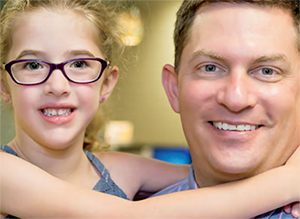Andrew M. Miller, MD, was new to practice and started working up patients on his own. But he was unsatisfied with his patient flow and the number of encounters he was able to handle in a given day. So he made the single biggest choice of his young career — he hired additional staff and saw his patient visits jump 17 percent.
How can you get the same results? In this interview, YO Info sat down with Dr. Miller and Leah Reznick, MD — two pediatric specialists — to talk about how they manage their patient numbers and how you can integrate their ideas into your own practice. For more on practice flow, be sure to check out YO Info’s retina and glaucoma roundtables.
Practice Flow in a Multispecialty Group Practice
Houston Eye Associates is the largest ophthalmology practice in the United States, with a team of 58 ophthalmologists, 20 optometrists and one audiologist serving 26 locations. We talked to pediatric specialist Dr. Miller, who joined the group out of fellowship 10 years ago.

Callie and Dr. Miller.
What is your practice’s patient volume?
Dr. Miller: There are a lot of children who need a pediatric ophthalmologist in our east Texas area, so it’s become a necessity to keep up with the high demand. On average, I have 45 patients per day and 40 surgeries per month — which adds up to about 600 to 700 patient encounters each month.
How does your practice handle high patient volume in a time-efficient manner?
Dr. Miller: It’s critical that you recognize each employee’s capabilities and responsibilities. In turn, it’s important that you as the ophthalmologist let each employee do their job. If you’re doing things that an ophthalmic assistant can do, you’re not using your time efficiently.
As your practice grows, the volume itself will help you figure out how and when to add staff in a cost-effective manner. For example, I started out working up my own patients until I reached eight encounters in a given half day. At that point, I added an ophthalmic assistant and covered the cost by seeing about 2.5 additional patients in a full day. So when I found out that this one extra assistant actually allowed me to see five extra patients in a half day, the benefits became obvious.
But you as the physician can only see so many patients. A practice can add staff and increase its volume, but ultimately you become the rate-limiting factor.
Is there a singular experience that helped you redefine your practice flow?
Dr. Miller: The single biggest event that improved my practice efficiency was hiring an orthoptist. Orthoptists are mid-level pediatric providers who specialize in evaluating and managing disorders of ocular motility and binocular vision — all with indirect supervision by the ophthalmologist. They basically function as physician extenders and cover a lot of the more time-consuming tasks — like motility measurements — for which I was previously responsible. This frees up openings on my schedule and raises the bar for the number of new and established patients I can see in a given day.
Orthoptists are also excellent at discussing patient education with children and their families. So, with their help, I’m now able to provide more efficient care, improve patient satisfaction and increase my patient capacity — all of which helps my revenue stream.
Again, why should a physician do something that a qualified and trained support staff can do? Be efficient in your role as a physician!
And here’s the proof: After hiring my first orthoptist, I was able to increase my patient visits by 17 percent, increase my surgical volume by 40 percent, increase my collections per visit by 22 percent and increase my overall collections by 43 percent.
(Note: To read more about Dr. Miller’s experience with orthoptists, check out “Pediatric Ophthalmology Practice Efficiency: Utilization of Orthoptists as Partners in the Pediatric Eye Care Team” in the American Orthoptic Journal.)
How do you get things back on track when practice flow slows down?
Dr. Miller: The key to a smooth day in the clinic is paying attention to the schedule. However, one of the biggest issues in our clinic is when referring physicians want you to see a patient “who absolutely cannot wait” until your next opening. If you don’t build in buffer slots for these types of urgent situations, your flow will always be erratic and unpredictable.
I also implemented a first-come, first-serve “open schedule” in which about 20 percent of my “new patient” slots don’t become available for appointment until a week prior. This gives families easier access to our services if they want to get in sooner. As a result, my show rates have dramatically improved because these families almost always follow through with their appointments. This schedule also gives me flexibility to move patients around (or close the slots entirely) if I have to close down due to an illness or another unexpected event.
Practice Flow in a Large Academic Institution

Dr. Reznick with a young patient.
Elks Children’s Eye Clinic at the Casey Eye Institute is an academic outpatient practice at the Oregon Health and Science University in Portland. We talked to pediatric specialist Leah Reznick, MD, 10 years in the practice.
What is your practice’s patient volume?
Dr. Reznick: The clinic’s pediatric division is comprised of seven providers — six ophthalmologists and one optometrist — who see 25 to 30 patients per day. I myself see patients 2.5 days per week in clinic and perform surgery a half day per week.
How does your practice handle high patient volume in a time-efficient manner?
Dr. Reznick: We have tried to create an optimal template to maximize flow through research and computer simulation. Our researchers used the time-stamp data from our electronic health record system to determine the average times of a patient visit. This included time spent with staff and providers and time spent waiting. We were also able to identify the specific types of patients that required additional time with staff and providers.
With this information at hand, we created computer simulations of scheduling templates that would reduce the average wait times for patients. Our researchers and staff staff tested and then implemented these simulations, and they’ve really helped reduce the clinical time per session.
As you can see in the table below, my schedule is organized into short, medium and long visits.
| Time |
# Slots |
Patient Type |
Dilated? |
Notes |
| 8 a.m. |
2 |
Short |
One of each |
Must be Short |
| 8:15 a.m. |
1 |
Short |
Either |
Can be Medium |
| 8:30 a.m. |
1 |
Short |
No |
Can be Medium |
| 8:45 a.m. |
1 |
Medium |
Yes |
Can be Short |
| 9 a.m. |
1 |
Medium |
No |
Can be Short |
| 9:15 a.m. |
1 |
Medium |
Yes |
Can be Short |
| 9:30 a.m. |
1 |
Medium |
No |
Can be Short |
| 9:45 a.m. |
1 |
Medium |
Yes |
Can be Short |
| 10 a.m. |
1 |
Long |
Yes |
|
| 10:15 a.m. |
1 |
Blank |
|
Use for overbooks* |
| 10:30 a.m. |
1 |
Long |
Yes |
|
| 10:45 a.m. |
1 |
Long |
No |
|
| 11 a.m. |
1 |
Medium |
No |
Can be Short |
| 11:15 a.m. |
1 |
Medium |
No |
Can be Short |
| 11:30 a.m. |
1 |
Medium |
No |
Can be Short |
| *Can schedule this block instead of 11:30 a.m. block. |
New patients and adult strabismus patients are considered long visits. For the rest of the returning patients, the provider predicts whether their next visit will be of the short, medium or long category:
- Short return visits are for amblyopia checks, retinopathy of prematurity follow-ups or quick alignment checks.
- Medium return visits are typically for dilated exams.
- Long return visits are usually for adults and those patients who require surgery and an extended discussion about their treatment.
We split up the schedule into 15-minute appointments for each half day. The short visits occur at the beginning of the session so that the provider can see those patients right away — rather than wait for dilated patients to be ready 45 minutes into the session. And by placing the long visits towards the end of the half day, we avoid having other patients wait around if these more complex appointments take up an extended amount of time.
These scheduling templates have turned out to be really helpful. In our initial pilot study, researchers found that average wait times improved from 39 to 25 minutes. And now that we have fully implemented these templates in our clinic, we’ll have more robust data coming out in the near future.
How do you get things back on track when practice flow slows down?
Dr. Reznick: To have a large patient volume with good flow, you need to always think and act efficiently. For each encounter, I preemptively look at the chart to determine the salient components of the exam and plan my discussion with the patient. This allows me to be very focused. And when talking to patients, I try to provide clear and concise explanations of problems and treatment plans. This really helps the visit move along quickly and productively.
Having everyone follow our scheduling templates is also key for successful practice flow. However, there are many situations that are out of our control. For example, we can’t control if patients are early or late. You just have to handle it the best you can — regardless of whether you make early patients wait their turn for a scheduled appointment or make late patients wait till after you see the on-time appointments first.
Dr. Reznick: And you’ll always have some patients who present with very complex — and unexpected— problems and who require a prolonged conversation. Rather than limiting my time with them, I first see those patients who are doing well and don’t require a lengthy examination. Afterwards, I’ll move on to the more complex patients. We’re always careful to provide a clear explanation that we want to spend significant time with them, and in order to do so, they’ll need to wait a little longer.
* * *
About the author: Mike Mott is a former assistant editor for EyeNet Magazine and contributing writer for YO Info.